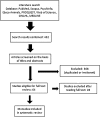Animal assisted intervention: A systematic review of benefits and risks
- PMID: 32362955
- PMCID: PMC7185850
- DOI: 10.1016/j.eujim.2016.05.005
Animal assisted intervention: A systematic review of benefits and risks
Abstract
Introduction: The therapeutic use of animals has been debated for decades, and its use explored in a variety of settings and populations. However, there is no uniformity on naming these interventions. Evidence based knowledge is essential to implement effective strategies in hospital. This review focused on the use of animal programs for hospitalized patients, and considered the potential risks.
Methods: The following databases were searched: PubMed, Scopus, PsychInfo, Ebsco Animals, PROQUEST, Web of Science, CINAHL, and MEDLINE, and PRISMA guidelines were adhered to.
Results: Out of 432 articles were identified 36 articles suitable for inclusion into the review. Data was heterogeneous in terms of age of patient, health issue, animals used and the length of interactions, which made comparison problematic. Studies on children, psychiatric and elderly patients were the most common. The animal-intervention programs suggested various benefits such as reducing stress, pain and anxiety. Other outcomes considered were changes in vital signs, and nutritional intake. Most studies used dogs, but other animals were effectively employed. The major risks outlined were allergies, infections and animal-related accidents. Zoonosis was a possible risk, as well as common infections as Methicillin-resistant Staphylococcus Aureus. The implementation of simple hygiene protocols was effective at minimizing risk. The literature suggested that the benefits outweighed by far the risks.
Conclusion: The human relationship with animals can be useful and relatively safe for inpatients with various problems. Moreover, the implementation of security precautions and the careful selection of patients should minimize the risks, particularly those infection-related. Many aspects remain unclear, further studies are required.
Keywords: Animal-assisted activity; Animal-assisted intervention; Animal-assisted therapy; Benefits; Clinical guidelines; Hospital; Pet-therapy; Risks & benefits; Systematic review.
© 2016 Elsevier GmbH. All rights reserved.
Figures
Similar articles
-
Beyond the black stump: rapid reviews of health research issues affecting regional, rural and remote Australia.Med J Aust. 2020 Dec;213 Suppl 11:S3-S32.e1. doi: 10.5694/mja2.50881. Med J Aust. 2020. PMID: 33314144
-
Prevention of falls and fall-related injuries in community-dwelling seniors: an evidence-based analysis.Ont Health Technol Assess Ser. 2008;8(2):1-78. Epub 2008 Oct 1. Ont Health Technol Assess Ser. 2008. PMID: 23074507 Free PMC article.
-
The Research of Standardized Protocols for Dog Involvement in Animal-Assisted Therapy: A Systematic Review.Animals (Basel). 2021 Sep 2;11(9):2576. doi: 10.3390/ani11092576. Animals (Basel). 2021. PMID: 34573542 Free PMC article. Review.
-
The effectiveness of mindfulness based programs in reducing stress experienced by nurses in adult hospital settings: a systematic review of quantitative evidence protocol.JBI Database System Rev Implement Rep. 2015 Oct;13(10):21-9. doi: 10.11124/jbisrir-2015-2380. JBI Database System Rev Implement Rep. 2015. PMID: 26571279
-
Systematic reviews of the effectiveness of day care for people with severe mental disorders: (1) acute day hospital versus admission; (2) vocational rehabilitation; (3) day hospital versus outpatient care.Health Technol Assess. 2001;5(21):1-75. doi: 10.3310/hta5210. Health Technol Assess. 2001. PMID: 11532238 Review.
Cited by
-
Presence of Campylobacterjejuni and C. coli in Dogs under Training for Animal-Assisted Therapies.Int J Environ Res Public Health. 2021 Apr 2;18(7):3717. doi: 10.3390/ijerph18073717. Int J Environ Res Public Health. 2021. PMID: 33918252 Free PMC article.
-
Animal-Assisted Interventions Improve Mental, But Not Cognitive or Physiological Health Outcomes of Higher Education Students: a Systematic Review and Meta-analysis.Int J Ment Health Addict. 2022 Nov 15:1-32. doi: 10.1007/s11469-022-00945-4. Online ahead of print. Int J Ment Health Addict. 2022. PMID: 36406903 Free PMC article.
-
Changes of Oxytocin and Serotonin Values in Dialysis Patients after Animal Assisted Activities (AAAs) with a Dog—A Preliminary Study.Animals (Basel). 2019 Aug 3;9(8):526. doi: 10.3390/ani9080526. Animals (Basel). 2019. PMID: 31382576 Free PMC article.
-
Examining the Impact of Virtual Animal Stimuli on College Students' Affect and Perception of their Academic Advising Experience.Animals (Basel). 2023 May 1;13(9):1522. doi: 10.3390/ani13091522. Animals (Basel). 2023. PMID: 37174559 Free PMC article.
-
Surveillance of Zoonotic Parasites in Animals Involved in Animal-Assisted Interventions (AAIs).Int J Environ Res Public Health. 2020 Oct 28;17(21):7914. doi: 10.3390/ijerph17217914. Int J Environ Res Public Health. 2020. PMID: 33126661 Free PMC article.
References
-
- Levinson B.M. Pets and personality development. Psychol. Rep. 1978;42(June 1 (3c)):1031–1038.
-
- Linee guida nazionali per gli interventi assistiti con gli animali (IAA) Conferenze Stato Regioni e Unificata [Internet] 2016 http://www.statoregioni.it/testo_print.asp?idprov=13952&iddoc=46922&tipo... (cited 22.04.16)
-
- Pet Partners.org – Therapy Pets & Animal Assisted Activities [Internet]. Available from: https://petpartners.org/learn/terminology/ (cited 22.04.16).
-
- Kamioka H., Okada S., Tsutani K., Park H., Okuizumi H., Handa S., Oshio T., Park S.J., Kitayuguchi J., Abe T., Honda T., Mutoh Y. Effectiveness of animal-assisted therapy: a systematic review of randomized controlled trials. Complement. Ther. Med. 2014;22(April (2)):371–390. - PubMed
-
- Urbanski B.L., Lazenby M. Distress among hospitalized pediatric cancer patients modified by pet-therapy intervention to improve quality of life. J. Pediatr. Oncol. Nurs. 2012;29(October (5)):272–282. - PubMed
Publication types
LinkOut - more resources
Full Text Sources
Medical

